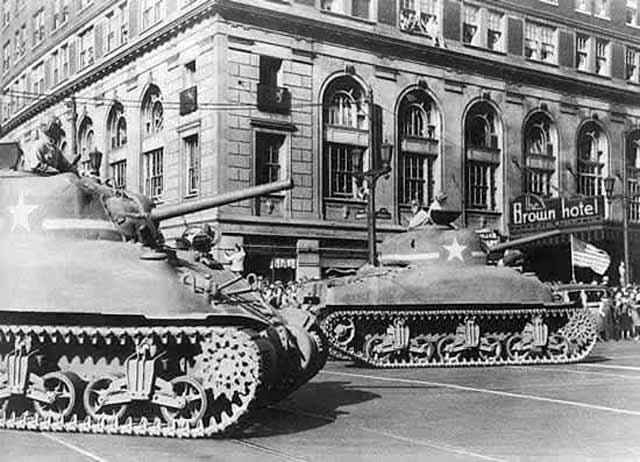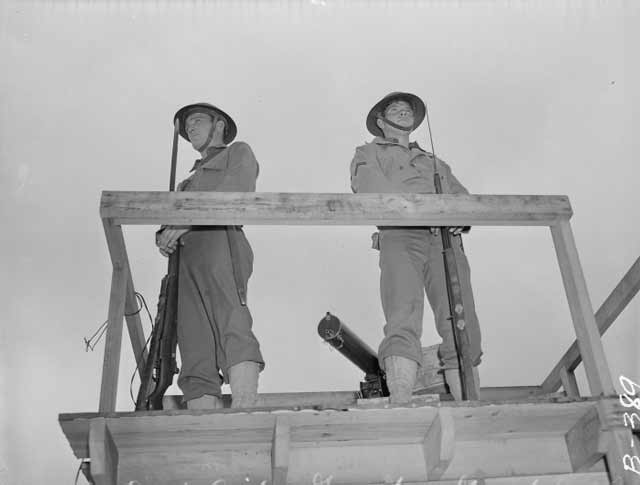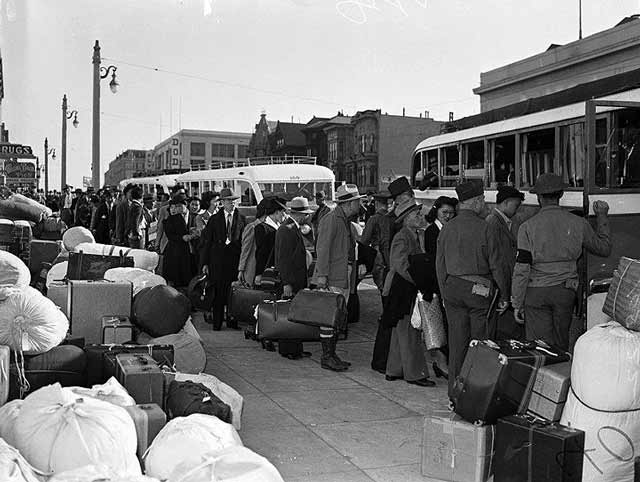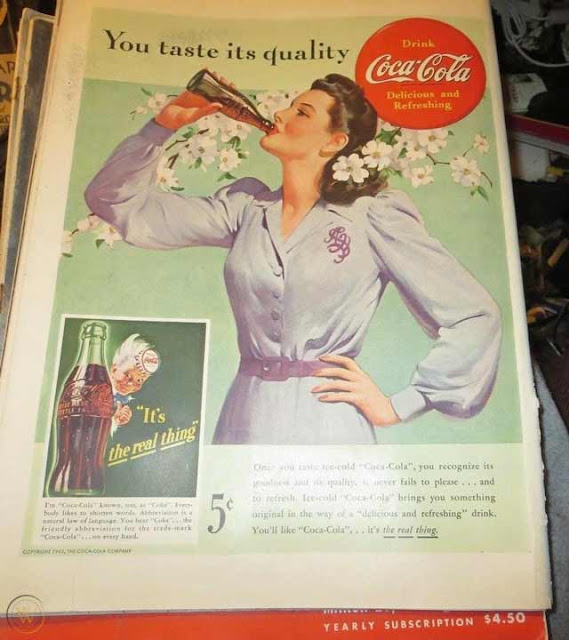Monday 6 April 1942
 |
| M4A1 tanks on parade for Army Day, 6 April 1942, in front of the Brown Hotel in Louisville, Kentucky. |
Battle of the Indian Ocean: The Japanese Indian Ocean raid, Operation C, continues on 6 April 1942. The Japanese Kido Butai strike group wreaks devastation throughout the Bay of Bengal, sinking freighter and tankers left and right, most of whom are probably completely oblivious to the presence of the most powerful enemy fleet in existence nearby. The ships sunk are listed below.
However, despite clearing the seas of enemy shipping, the Japanese have a problem. While he does not realize it, Japanese Admiral Nagumo is sailing away from the British Eastern Fleet that it is his mission to destroy. On the British side, Admiral James Somerville now realizes that the Japanese fleet includes four aircraft carriers and three battleships and that this force is superior to his own forces. Thus, he does not get overly aggressive. During the day, the British reinforce their Force A with Force B and they advance to the vicinity of where the Japanese recently sank cruisers heavy cruisers HMS Cornwall and Dorsetshire. There, the British rescue 1122 survivors. However, Somerville does not know where the Japanese are and thus is operating in the dark.
While the British Eastern Fleet is occupied with the Kido Butai strike group, the Japanese land troops at Rangoon. General Chiang Kai-Shek decides to send another division to help the Burma I Corps and directs the Chinese 200th and 96th Divisions in Burma to hold Pyinmana and Taungdwingyi, Burma.
On the Bataan Peninsula in the Philippines, the situation does not improve for the Allies. A counterattack by II Corps (eastern end of the line) runs head-on into a Japanese attack and is forced back. A separate counterattack a little further east by US 31st Infantry and the Filipino 21st Division to close the breach at Mount Samat also fails. Another counterattack toward Mount Samat from a little to the west is smashed, with the Filipino 33rd Infantry surrounded and presumed lost. The situation at II Corps is in chaos, while the I Corps holding the western end of the line is doing only a little better. The Allied troops in the west withdraw to the San Vicente River. Two river gunboats, USS Mindanao and Oahu intercept the Japanese landing craft and claim four sunk, but later in the day, the Mindanao is damaged in another firefight.
Eastern Front: The five divisions of German General Seydlitz are making very slow progress along the Staraya Russa - Demyansk road. While the Germans only have six miles to reach the Lovat River and a total of 20 miles to relieve the Demyansk pocket, the Soviets have brought in heavy reinforcements and the going is very slow. There is some question about whether the roughly 100,000 Germans trapped in Demyansk (and the much smaller force at Kholm) can hold out much longer, so the Luftwaffe comes to their rescue. It flies 360 sorties today to and from the pockets, escorted by fighters of JG 51 and 53. The Germans are fortunate that the Soviets have been unable to bring up heavy anti-aircraft units in the 20 miles between the lines, but the flights are still somewhat hazardous due to ground fire. The German Ju 52s fly at treetop level to minimize the danger and drop many of their supply pallets by parachute, some of which drift into Soviet hands or into no-man's land, causing firefights to break out.
The Luftwaffe continues its air offensive against the Soviet fleet at the naval base on Kronstadt island just outside of Leningrad. Soviet battleship Oktyabrskaya Revolutsiya and cruiser Maksim Gorki are hit and badly damaged by Heinkel He 111 medium bombers of Kampfgeschwader 4, but no ships are sunk.
In other attacks, one RAF bomber attacks Schipol Airfield and another the port area at Ostend.
Battle of the Mediterranean: Royal Navy destroyer HMS Havock runs aground at Kelibia on the Cap Bon peninsula, Tunisia. Havock is wrecked (later finished off with a torpedo from Italian submarine Aradam) and one crewman perishes, with 150 crewmen and 100 soldier passengers rescued. The Vichy French control Tunisia, and they follow the rules of war by interning the British crew and passengers (released in November 1942 due to Operation Torch).
Axis bombers attack Alexandria and continue their air offensive against Malta. Among the victims today is the Royal Navy tugboat HMS West Cocker.
Partisans: Operation Bamberg, a German antipartisan military attack on known partisan hideouts in the area of Bobruysk in the Belorussian region of the German-occupied western USSR, concludes. Bamberg is the prototype for future German antipartisan operations. Mounted by the reinforced 707th Division, a Slovak infantry regiment, and the 315th Schutzpolizeibataillon, Operation Bamberg involved drawing a "noose" around the partisan area and then moving inward to flush out the partisans. This strategy comports with the recent Fuhrer Directive No. 41 order to "mop up" behind the front.
 |
| The Clarksville, Tennessee, Leaf-Chronicle accurately sums up the war situation on 6 April 1942. |
The massive Japanese fleet, meanwhile, after withdrawing to the southwest after their attack on Colombo, has circled around again to the northeast roughly toward Ceylon (Sri Lanka). During the day, heavy cruisers Kumano and Suzuya along with destroyer Shirakumo of the Northern Group under rear Admiral Kurita Takeo encounter and sink British freighters Silksworth, Autolycus, Malda, and Shinkuang and the American ship Exmoor. The Central Group also sinks a freighter, while the Southern Group sinks three freighters.
To give some perspective, let's look at the damage going on in the Bay of Bengal on 6 April 1942. Ships sunk and damaged today in the Bay of Bengal include:
- Dutch freighter Van Der Capellen (damaged by planes from aircraft carrier Ryujo)
- British freighter Taksang (sunk by cruisers Yura and Yugiri)
- British freighter Silksworth (sunk by cruisers Kumano, Suzuya, and Shirakumo, 50 survivors)
- British freighter Shinkuang (sunk by cruisers Kumano, Suzuya, and Shirakumo)
- British freighter Shinkiang (sunk by planes from Ryujo)
- US freighter Selma City (sunk by floatplanes from cruiser Chokai)
- British freighter Malda (sunk by cruisers Kumano, Suzuya, and Shirakumo)
- British freighter Indora (sunk by cruisers Kumano, Suzuya, and Shirakumo
- Norwegian freighter Hermod (sunk by two cruisers, all 36 men survive)
- British freighter Ganges (sunk by floatplanes from cruiser Chokai)
- British freighter Gandara (sunk by cruisers Mikuma, Mogami, and Amagiri)
- US freighter Exmoor (sunk by cruisers Kumano and Suzuya)
- Norwegian tanker Elsa (sunk by two cruisers, 1 of 30 crew dead)
- Norwegian freighter Dagfred (sunk by two cruisers (all 40 men survive)
- US freighter Bienville (sunk by planes from Ryujo and cruiser Chokai with 24 dead)
- Dutch freighter Batavia (sunk by cruisers Yura and Yugiri)
- Dutch freighter Banjoewangi (sunk by cruisers Uyra and Yugiri)
- British freighter Autolycus (sunk by cruisers Kumano, Suzuya, and Shirakumo).
No matter how you look at it, that's a lot of sunk and damaged ships. The only "silver lining" for the Allies is that they manage to avoid losing any major warships today. However, they've already lost two cruisers and other naval vessels during the Indian Ocean raid - and, without giving anything away, they're about to lose more, too.
Nagumo's next target to draw out the British fleet is Trincomalee on Ceylon, but this will take a couple of days to set up. In the interim, his overpowering might will continue to clear the seas of Allied shipping.
 |
| Twin Falls, Idaho, Times News, 6 April 1942. |
Separately, Japanese submarine HIJMS I-5 catches and sinks a US freighter about 216 miles northwest of the Maldive Islands. I-4 also sinks a US freighter at the entrance to Eight Degree Channel, the Washingtonian. The 42-man crew makes it to the Maldive Islands. Japanese bombers also sink Indian sloop HMIS Indus at Akyab, Burma, with ten crewmen wounded.
While the British Eastern Fleet is occupied with the Kido Butai strike group, the Japanese land troops at Rangoon. General Chiang Kai-Shek decides to send another division to help the Burma I Corps and directs the Chinese 200th and 96th Divisions in Burma to hold Pyinmana and Taungdwingyi, Burma.
The Japanese Air Force also creates problems for the Allies by conducting their first bombing raid on India. They attack Coconada and Madras.
 |
| Honolulu, Hawaii, Advertiser, 6 April 1942. This copy was sent by a US Army Private to his mother in Kansas. |
Battle of the Pacific: The Japanese continue occupying areas that the Allies have abandoned. They send a small force from Truk Atoll in the Caroline Islands to the Lorengau on the eastern shore of Manus Island in the Bismarck Archipelago. Also on the Bismarck Archipelago, the US Army Air Force bombs Gasmata, New Britain Island.
Lieutenant Colonel Jame H. Doolittle remains at sea aboard the USS Hornet en route to Japan. This is a complex operation, and today the Assam-Burma-China Ferry Command begins hauling 30,000 gallons of aviation fuel and 500 gallons of lubricants from Calcutta to Asansol in West Bengal, India, for his bombers. Of course, the Doolittle bombers will need to survive the mission and make it to India via China to be able to use these supplies.
On the Bataan Peninsula in the Philippines, the situation does not improve for the Allies. A counterattack by II Corps (eastern end of the line) runs head-on into a Japanese attack and is forced back. A separate counterattack a little further east by US 31st Infantry and the Filipino 21st Division to close the breach at Mount Samat also fails. Another counterattack toward Mount Samat from a little to the west is smashed, with the Filipino 33rd Infantry surrounded and presumed lost. The situation at II Corps is in chaos, while the I Corps holding the western end of the line is doing only a little better. The Allied troops in the west withdraw to the San Vicente River. Two river gunboats, USS Mindanao and Oahu intercept the Japanese landing craft and claim four sunk, but later in the day, the Mindanao is damaged in another firefight.
 |
| Military police on a watchtower overlooking the Santa Anita Assembly Center in California, 6 April 1942 (Photographer Clem Albers. National Archives Ctrl.#: NWDNS-210-G-B389; NARA ARC#: 537020). |
The Luftwaffe continues its air offensive against the Soviet fleet at the naval base on Kronstadt island just outside of Leningrad. Soviet battleship Oktyabrskaya Revolutsiya and cruiser Maksim Gorki are hit and badly damaged by Heinkel He 111 medium bombers of Kampfgeschwader 4, but no ships are sunk.
 |
| RAF aerial reconnaissance photo of the Kriegsmarine base at Swinemünde (Świnoujście), 6 April 1942. Number 1 is cruiser Emden, No. 2 is cruiser Leipzig (Naval History and Heritage Command NH 80497). |
European Air Operations: Tonight's main target for RAF Bomber Command is Essen, a frequent objective. The RAF sends 157 bombers, but they encounter terrible weather conditions including cloud cover of the target. While 49 bomber crews claim to have reached and bombed the target, few bombs actually fall in Essen and there are no casualties and light damage. The RAF loses five bombers (2 Hampdens and one apiece of Manchesters, Stirlings, and Wellingtons) on this failed raid.
In other attacks, one RAF bomber attacks Schipol Airfield and another the port area at Ostend.
 |
| Norwegian tanker Koll, sunk by U-571 on 6 April 1942. |
Battle of the Atlantic: U-160 (Oblt. Georg Lassen), on its first patrol out of Helgoland, scores its fourth victory at 08:07 when it damages 6837-ton US tanker Bidwell about 50 miles southeast of Cape Lookout, North Carolina. Showered with burning oil, the second mate jumps overboard and is drowned, but that is the only casualty. The tanker continues to steam forward, but the steering gear is damaged so it just steams in a circle (like the Bismarck in May 1941). Two US destroyers arrive within two hours, and the ship's steering issues are repaired sufficiently for it to make port in Hampton Roads, Virginia.
U-571 (Kptlt. Helmut Möhlmann), on its fourth patrol out of La Pallice, torpedoes and sinks 10,044-ton Norwegian tanker Koll east of Cape Hatteras. When it doesn't sink right away, the U-boat surfaces to give the men in the boats some crackers and uses its deck gun to fire 30 rounds and finish off the tanker. There are three dead and 33 survivors. Two lifeboats from Koll are at sea until the 14th before being picked up by passing freighters.
U-754 (Kptlt. Hans Oestermann), on its second patrol out of Brest, winds up a very successful patrol (its best of the war) by torpedoing and sinking 9858-ton Norwegian tanker Kollskegg about 350 miles northwest of Bermuda. There are 4 dead and 38 survivors. This incident is unusual in that the men in the Kollskegg boats spot the lifeboats from the Koll, also sunk today as mentioned above, though they are later separated.
Battle of the Mediterranean: Royal Navy destroyer HMS Havock runs aground at Kelibia on the Cap Bon peninsula, Tunisia. Havock is wrecked (later finished off with a torpedo from Italian submarine Aradam) and one crewman perishes, with 150 crewmen and 100 soldier passengers rescued. The Vichy French control Tunisia, and they follow the rules of war by interning the British crew and passengers (released in November 1942 due to Operation Torch).
Axis bombers attack Alexandria and continue their air offensive against Malta. Among the victims today is the Royal Navy tugboat HMS West Cocker.
 |
| Japanese internment evacuation at Van Ness in the Fillmore neighborhood of San Francisco, 6 April 1942 (Bancroft Library). |
While closely followed by the German high command (including Adolf Hitler via the OKH) which placed high hopes in it, Bamberg turns out at best to be a mixed success. On the positive side, any actual partisan bases are torched and active partisan operations in the area are stopped, at least for the time being. However, there are many questionable results. The Germans find that identifying actual partisans is difficult, as they purposefully blend in with local inhabitants. Many people identified as partisans may or may not be so, so any numbers on partisans eliminated (the Germans claim 3600) are suspect. One of the German tactics is to destroy villages and farms in the "hot zone" at the center of the target area, which earns the Germans enmity in the region and probably just creates more partisans. However, despite its failings, Operation Bamberg becomes the template for future antipartisan operations, of which there are many to come.
Spy Stuff: U-252 (Kptlt. Kai Lerchen) lands spy Ib Arnason Riis in northern Iceland on the remote Langanes Peninsula. Riis is half-Iceland and half-Danish and a reluctant Abwehr recruit. After being dropped off in poor weather, Riis walks for 17 hours through rain and snow until he finds a farmhouse where he gives himself up. After being interrogated in Reykjavik, Riis leads army officers back to Langanes where he digs up his buried radio and other equipment. He becomes a double agent, feeding the Germans false information under the supervision of a British naval officer. The Germans are completely unaware of his treachery and award him the Iron Cross 2nd and 1st Class - making Ib Riis the only Icelander to receive those awards.
Japanese/Soviet Relations: After riding the Trans-Siberian Railway, Naotake Satō, the new Japanese Ambassador to the USSR, presents his credentials to Soviet Foreign Minister Vyacheslav Molotov. In the confusing politics of the era, Japan is at war with several of the Soviet Union's main allies but is not at war with the Soviet Union. Satō will serve as the Japanese ambassador to the Soviet Union for the remainder of World War II and be involved in murky negotiations with Molotov regarding possible peace deals with the Allies that never pan out.
Japanese/Soviet Relations: After riding the Trans-Siberian Railway, Naotake Satō, the new Japanese Ambassador to the USSR, presents his credentials to Soviet Foreign Minister Vyacheslav Molotov. In the confusing politics of the era, Japan is at war with several of the Soviet Union's main allies but is not at war with the Soviet Union. Satō will serve as the Japanese ambassador to the Soviet Union for the remainder of World War II and be involved in murky negotiations with Molotov regarding possible peace deals with the Allies that never pan out.
 |
| A Coca Cola ad, 6 April 1942 Life magazine. |
US Military: US troops continue to flow into Australia. Today, the 41st Infantry Division, the 163d Infantry, the 167th Field Artillery Battalion, and other units arrive in Melbourne, Victoria. They become part of General Douglas MacArthur's Army Forces in Australia.
The USAAF Fifth Air Force sends the 11th and 12th Bombardment Squadrons, 7th Bomber Group (Heavy) sans equipment back to the United States to re-equip. The units will proceed to Columbia, South Carolina, to receive B-25 bombers.
Canadian Military: The First Canadian Army forms in the United Kingdom. Its commander is Lieutenant General Andrew McNaughton.
 |
| Life magazine, 6 April 1942. |
American Homefront: In Proclamation 2542 of 20 March 1942, President Roosevelt proclaimed April 6, 1942, as Army Day. In that Proclamation, FDR wrote:
Army Day becomes, therefore, in fact a total-war day. It becomes a day when all of our citizens in civil pursuits can rally to the support of our armed forces, for only in the united effort of all of our forces—Army, Navy, and civilians—can we find the strength to defeat our enemies.
The Axis powers have not yet adopted the phrase "Total War" to describe their war effort. The Reich will not do that until after Stalingrad, in another year.
Future History: Barry Levinson is born in Baltimore, Maryland. After starting out as a television writer, Levinson becomes a prominent filmmaker, screenwriter, and occasional actor. His major breakthrough is with "Diner" (1982), set in his native Baltimore. His extensive list of films written, directed, or produced includes "High Anxiety" (1977), "Tin Men" (1987), and "Good Morning, Vietnam" (1987). Barry Levinson remains active in the film industry as of 2020.
 |
| Time magazine, 6 April 1942, with Ezequiel Padilla (Mexican Secretary of Foreign Affairs) on the cover (cover credit Ernest Hamlin Baker). |
April 1942
April 1, 1942: Convoys Come to the USAApril 2, 1942: Doolittle Raiders Leave Port
April 3, 1942: Japanese Attack in Bataan
April 4, 1942: Luftwaffe Attacks Kronstadt
April 5, 1942: Japanese Easter Sunday Raid on Ceylon
April 6, 1942: Japanese Devastation In Bay of Bengal
April 7, 1942: Valletta, Malta, Destroyed
April 8, 1942: US Bataan Defenses Collapse
April 9, 1942: US Defeat in Bataan
April 10, 1942: The Bataan Death March
April 11, 1942: The Sea War Heats Up
April 12, 1942: Essen Raids Conclude Dismally
April 13, 1942: Convoy QP-10 Destruction
April 14, 1942: Demyansk Breakout Attempt
April 15, 1942: Sobibor Extermination Camp Opens
April 16, 1942: Oil Field Ablaze in Burma
April 17, 1942: The Disastrous Augsburg Raid
April 18, 1942: The Doolittle Raid bombs Japan
April 19, 1942: British in Burma Escape
April 20, 1942: The Operation Calendar Disaster
April 21, 1942: Germans Relieve Demyansk
2021
No comments:
Post a Comment